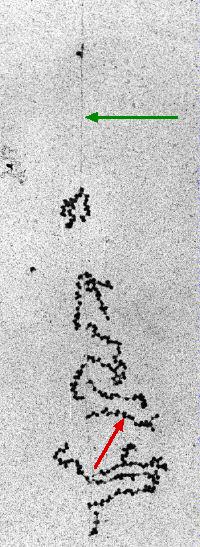
Simultaneous transcription and translation of E. coli genes.
The long fiber running from top to bottom (green arrow ) is a segment of the E. coli chromosome.
Extending from it are polysomes (red arrow), the size of which generally increases from top to bottom.
Each polysome consists of a backbone of messenger RNA (mRNA) to which the ribosomes are attached.
Each polysome is attached to the DNA fiber by a complex of proteins that includes a molecule of RNA polymerase. Thus- the DNA is transcribed by RNA polymerase molecules moving from top to bottom, and
- the growing mRNA molecules are translated by ribosomes moving in a proximal -> distal direction.
In E. coli, then, and probably in all bacteria, the transcription of DNA into mRNA and the translation of mRNA into polypeptides (not visible here) are closely coordinated in both time and space.
In eukaryotes, in contrast, while all transcription takes place in the nucleus, most (but not all) translation of mRNA occurs later in the cytosol.
(Electron micrograph courtesy of O. L. Miller, Jr., B. A. Hamkalo, and C. A. Thomas, Jr.)